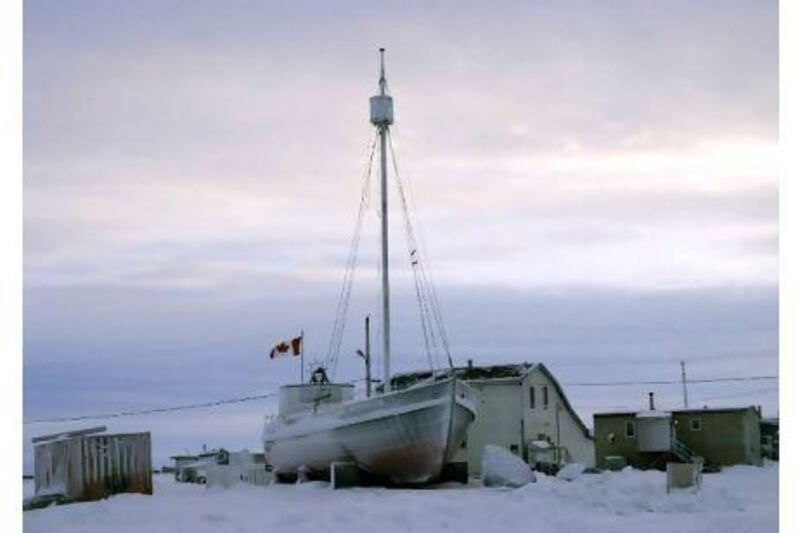TUKTOYAKTUK // Scattered along the edge of the village of Tuktoyaktuk, beside the frozen Beaufort Sea, along Canada's northern edge, are several clumps of silent buildings.
Aluminium-clad living quarters, with spaceship-style hatches and small, lightless windows, stand on metal stilts above the tundra. Hangars and storage tanks loom over long lines of still white shapes - vehicles and construction gear, half-buried in the snow.
There is a strong resemblance to the lifeless off-world base in the movie Aliens, and Tuktoyaktuk, in the Northwest Territories, is indeed an abandoned colony of sorts. The deserted buildings are oil and gas facilities, relics of 50 years of exploration that boomed after massive gas deposits were found in and around the Mackenzie River Delta.
Merven Gruben, the mayor of Tuktoyaktuk's 970 mainly Inuvialuit inhabitants, said: "We used to have a thousand exploration people based on the shore here, and 2,000 more at sea on the drill ships. There was work for anyone here who wanted it, but we lost half of our employment when the exploration stopped."
Forty years after it was first suggested, there is still no sign of a proposed 1,220km gas pipeline to link the Beaufort gas fields, via the Mackenzie River valley, to the North American energy grid in Alberta.
With Libya's oil production off-line, lingering doubts about the extent of Saudi reserves and Brent crude prices at US$112 a barrel, one might have expected a less-muted reaction to news last week that Canada's government had finally approved the pipeline.
Yet despite the looming energy crisis, work on the Mackenzie Valley pipeline will not begin any time soon.
In a new round of manoeuvring, the companies backing the pipeline - ConocoPhillips, Shell, ExxonMobil and Imperial - are asking the government to help underwrite the projected C$16.2 billion (Dh61bn) construction cost. Otherwise, with potential sources of cheaper shale gas available much closer to consumers, they argue that the pipeline might not be viable.
Beginning in the 1960s, and working in almost impossible conditions, drillers found huge amounts of gas in the Mackenzie Delta and the Beaufort Sea, an estimated 1.9 trillion cubic metres. By the end of the last decade, however, exploration activity had dwindled to nothing: there was no way to bring the gas to market.
The Beaufort Sea, frozen for several months of the year, is not suitable for tanker ships. Except in winter, when it is linked to the regional centre, Inuvik, by a 187-kilometre ice road ploughed along the frozen Mackenzie River and Beaufort Sea, Tuktoyaktuk cannot be reached by overland vehicles.
There are also numerous regulatory obstacles still to be overcome, mostly relating to environmental protection.
Pius Rolheiser, a spokesman for Imperial Oil, said: "To move ahead with the project we need over 6,000 additional permits for individual pieces of work - everything from crossing a stream, digging a gravel pit, putting in a temporary airstrip or a camp. We need to have these permits in hand or we don't have a decision to make. The earliest we'd be in a position to make an investment decision would be 2013."
Even then, construction work could not begin until the end of this decade, assuming the consortium could overcome objections from environmental groups, such as the Sierra Club, that want to preserve the region's pristine Arctic wilderness.
Peter Clarkson, an official of the Northwest Territories regional government and former wildlife biologist, said environmental concerns were genuine, but should be balanced against economic necessity.
"I've seen areas that were being drilled 20 years ago and now you can't see that there was ever anything there," he said.
An earlier incarnation of the pipeline project was blocked in 1977 when, after a landmark inquiry, Judge Thomas Berger ruled work could not proceed until aboriginal groups living in its path had settled land-rights claims against the federal government.
Today, most of these claims have been resolved, and the Aboriginal Pipeline Group, representing local Inuvialuit, Gwich'in and Sahtu peoples, is a one-third shareholder in the project.
Most local people seemed to broadly welcome the jobs, roads and development that the pipeline would bring to their remote and impoverished region. But some still have misgivings.
"For the people, I welcome it, but for myself, personally, I kind of don't want to see it," said Lennie Emaghok, a Tuktoyaktuk resident and Inuvialuit elder who has divided his life between working for the oil companies and traditional hunting, fishing and trapping.
"Outside people will come in and stay. Bringing in a gas pipeline will bring in oil companies, too, and I don't think people realise how it will change our land, where people hunt and trap. I'm worried about offshore. They've told us that with their new systems there's so many safety mechanisms that it can't go wrong. But it happened in Mexico."






